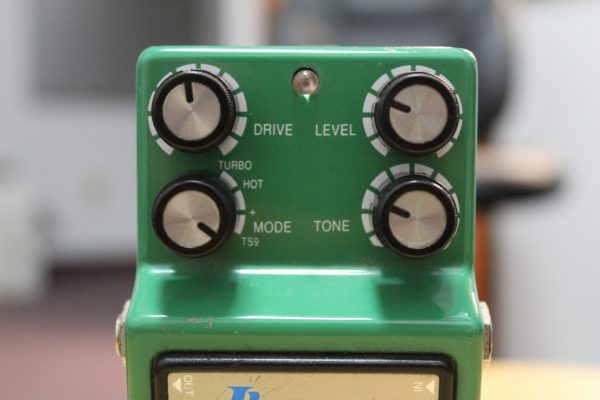
The Ibanez TS9DX is an upgraded “deluxe” version of the Ibanez TS9 Tubescreamer. It houses the original TS9 circuit, along with 3 additional modifications. The modified versions can be selected via a selector switch. In this post, I cover how I repaired one of these TS9DX’s, and the process behind how I did it.
As a member of the Reverb Partner Program and as an Amazon Associate, StompboxElectronics earns from, and is supported by, qualifying purchases.
Disclaimer: Stompbox Electronics and/or the author of this article is/are not responsible for any mishaps that occur as a result of applying this content.
Ibanez TS9DX Tubescreamer Deluxe
Behold the TS9DX Tubescreamer Deluxe! This deluxe pedal has the same internals as the original TS9 circuit with an added 4-position Mode switch. The Mode switch allows you to choose between four (4) seperate tone and gain variations. In fact, the parts of the circuit that are affected by the Mode switch include the clipping diode arrangement and a capacitor related to the Tone control.
The TS9DX Mode Configurations
As noted, the Mode knob switches between four (4) separate modes: TS9, Plus (+), Hot, and Turbo. See the table below for a brief explanation of each option, along with what it changes in the circuit:
| TS9DX Mode | Description |
|---|---|
| TS9 | This is our benchmark. The original TS9 circuit has symmetrical clipping diodes and a C4 Tone cap value of 47nF. |
| + (Plus) | C4 is swapped for 220nF. An additional diode is added in series on both branches of the clipping circuit. |
| Hot | C4 is swapped again, this time for 1uF electrolytic. The silicon diodes from the TS9 circuit are both swapped for red LEDs. Also, a 220k ohm resistor is added in parallel with the clipping diodes. |
| Turbo | Clipping diodes are completely removed and C4 is swapped again for a 22uF capacitor. |
For a more in-depth breakdown of the TS9DX circuit Mode configuration, see Ibanez TS9DX Modes and their Clipping Circuits.
Ibanez TS9DX Repair
Today, a TS9DX walked into the shop with an intermittent signal. Most of the time the signal passed, but when attempting to engage the pedal it would kick out; after a couple knocks the pedal would come back to life. The LED still turned on, so power was fine.
Initial Troubleshooting
One thing I noticed was that if I pressed the Mode switch inwards I could recreate the signal kicking out. What’s more is that same action would randomly bring the pedal back to life. From that, I concluded that a contact in the Mode switch had to be loose. That would explain the signal dropping out when pressing into the Mode switch. The same action would knock that “loose contact” back into position and the signal would come back.

Running with that suspicion, I was convinced there was a problem with the Mode switch. So, I ordered a new Mode switch and installed it. To my surprise, the pedal still acted the same way!
Round Two: Final Troubleshooting
That’s when the light-bulb lit. The TS9DX houses two daughter boards that hold the circuit components for each Mode configuration. This includes the diodes, tone caps, control potentiometers, and the Mode switch.
The daughter boards connect to the main board via simple 22 and 24 AWG wiring. Since the Mode switch is fixed on one of these daughter boards, the entire board must have felt the force of my thumb pushing onto the Mode switch. The force of my thumb must have bent the solder connection enough to dislodge it and cause an intermittent signal.

At that point it was clear what needed to be done: I reflowed all solder connections for the wiring between the main board and the daughter board. After doing that, the pedal came back to life and all was restored!
Meet the Author:

Hi, I’m Dominic. By day, I’m an engineer. By night, I repair and modify guitar effects! Since 2017, I’ve been independently modifying and repairing guitar effects and audio equipment under Mimmotronics Effects in Western New York. After coming out with a series of guitar effects development boards, I decided the next step is to support that community through content on what I’ve learned through the years. Writing about electronics gives me great joy, particularly because I love seeing what others do with the knowledge they gain about guitar effects and audio circuits. Feel free to reach out using the contact form!
Spotlight
This one goes out to Buffalo’s own Zak Ward (of the band First Ward). He’s also got some quality solo material you ought to check out: Zak Ward.
The Tools I Use
As a member of Amazon Associates, Stompbox Electronics earns and is supported by qualifying purchases.













